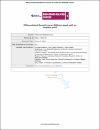Differentiated thyroid cancer: millions spent with no tangible gain?
| Author | Furuya-Kanamori, Luis |
| Author | Sedrakyan, Art |
| Author | Onitilo, Adedayo A |
| Author | Bagheri, Nasser |
| Author | Glasziou, Paul |
| Author | Doi, Suhail A.R. |
| Available date | 2017-10-22T05:35:41Z |
| Publication Date | 2017-10-17 |
| Publication Name | Endocrine-Related Cancer |
| Identifier | http://dx.doi.org/10.1530/ERC-17-0397 |
| Citation | Luis Furuya-Kanamori, Art Sedrakyan, Adedayo A Onitilo, Nasser Bagheri, Paul Glasziou, and Suhail A. R. Doi "Differentiated thyroid cancer: millions spent with no tangible gain?" Endocrien-Related Cancer ERC-17-0397, first published on 17 October 2017 |
| ISSN | 1351-0088 |
| Abstract | The incidence of differentiated thyroid cancer (DTC) has rapidly increased worldwide over the last decades. It is unknown if the increase in diagnosis has been mirrored by an increase in thyroidectomy rates with the concomitant economic impact that this would have on the healthcare system. DTC and thyroidectomy incidence as well as DTC specific mortality were modelled using Poisson regression in New South Wales (NSW), Australia per year and by sex. The incidence of 2002 was the point from which the increase in rates were assessed cumulatively over the subsequent decade. The economic burden of potentially avoidable thyroidectomies due to the increase in diagnosis was estimated as the product of the additional thyroidectomy procedures during a decade attributable to rates beyond those reported for 2002 and the national average hospital cost of an uncomplicated thyroidectomy in Australia. We found that the incidence of both DTC and thyroidectomy doubled in NSW between 2003 and 2012, while the DTC specific mortality rate remained unchanged over the same period. Based on the 2002 incidence, the projected increase over 10 years (2003-2012) in thyroidectomy procedures was 2,196. This translates to an extra cost burden of over AUD$ 18,600,000 in surgery-related healthcare expenditure over one decade in NSW. Our findings suggest that, if this rise is solely attributable to overdetection, then the rising expenditure serves no additional purpose. Reducing unnecessary detection and a conservative approach to managing DTC are sensible and would lead to millions of dollars in savings and reduced harms to patients. |
| Language | en |
| Publisher | Bio Scientifica |
| Subject | Differentiated thyroid cancer Economic impact Australia |
| Type | Article |
| ESSN | 1479-6821 |
Files in this item
This item appears in the following Collection(s)
-
Medicine Research [1508 items ]


